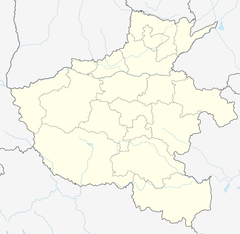| White Horse Temple | |
|---|---|
白马寺 | |
 White Horse Temple | |
| Religion | |
| Affiliation | Buddhism |
| Location | |
| Location | Luoyang, Henan |
| Country | China |
| Geographic coordinates | 34°43′26″N 112°35′59″E / 34.72389°N 112.59972°E |
| Architecture | |
| Style | Chinese architecture |
| Completed | 68 AD |
| White Horse Temple | |||||||||||||||
|---|---|---|---|---|---|---|---|---|---|---|---|---|---|---|---|
| Traditional Chinese | 白馬寺 | ||||||||||||||
| Simplified Chinese | 白马寺 | ||||||||||||||
| |||||||||||||||
White Horse Temple (Chinese: 白馬寺) is a Buddhist temple in Luoyang, Henan that, according to tradition, is the first Buddhist temple in China, having been first established in 68 AD under the patronage of Emperor Ming in the Eastern Han dynasty.[1][2][3]
The site is just outside the walls of the ancient Eastern Han capital, some 12–13 kilometres (7.5–8.1 mi) east of Luoyang in Henan Province. It is approximately 40 minutes by bus No. 56 from Luoyang railway station.[4] The temple, although small in comparison to many others in China, is considered by most believers as "the cradle of Chinese Buddhism".[5] The geographical landmarks to the south are Manghan mountain and Lucoche River.[6]
The main temple buildings, a large complex, were reconstructed during the Ming (1368 to 1644) and Qing (1644 to 1912) dynasties.[7] They were refurbished in the 1950s, and again in March 1973 after the Cultural Revolution. It has numerous halls divided by courtyards and manicured gardens, covering an area of about 13 hectares (32 acres). The display plaques in Chinese and English give ample descriptions of the Buddhist deities installed in the halls. Significant statues include Śākyamuni Buddha, Maitreya (the laughing Buddha in China), Amitābha, the Jade Buddha, Bodhisattvas such as Guanyin, and arhats and stone statues of the two white horses which brought the Indian monks to China and two mythical lions at the entrance.[1][2][3] Under international funding, the temple has undergone many changes, both structurally and internally. The most recent cooperative project, with India, was completed in 2008 when the Sanchi Stupa and the Sarnath Buddha statue were erected.
- ^ a b Leffman, David; Simon Lewis; Jeremy Atiya (2003). Rough Guide to China. Rough Guides. p. 307. ISBN 1-84353-019-8.
- ^ a b Bao, Yuheng; Qing Tian; Letitia Lane (2004). Buddhist Art and Architecture of China. Edwin Mellen Press. pp. 84, 172. ISBN 0-7734-6316-X.
- ^ a b Harper, Damien (2007). China. Lonely Planet. pp. 462–463. ISBN 978-1-74059-915-3.
- ^ Elmer, et al. (2009), p. 463.
- ^ "White Horse Temple". Buddha Channel. Retrieved 2010-04-30.
- ^ "White Horse Temple". China Culture. Archived from the original on 2009-12-20. Retrieved 2010-05-01.
- ^ Cummings, et al. (1991) p. 283.
